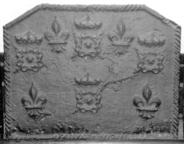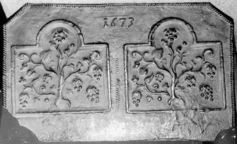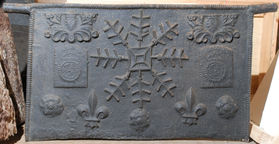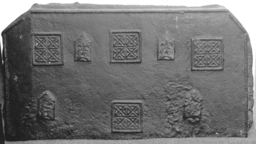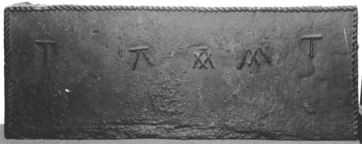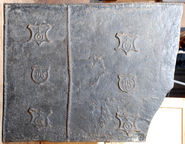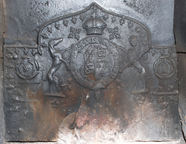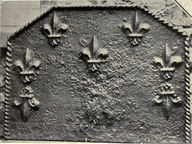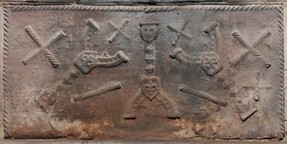-
128
Description: Canted rectangle; twisted rope edging (top and sides), with dowel across the top corners; symmetrical arrangement of four crowned four-petal roses, top centre, bottom centre and both top corners; symmetrical arrangement of four fleurs de lys, two either side of top central rose, two in bottom corners.
Notes: One of a large series bearing heraldic stamps. Given to Hastings Museum by Mr A. E. Anderson of Brightling Hall, Robertsbridge, Sussex.
- Decoration tags:
- rectangular with canted top corners (shape)
- rope (edging)
- carved stamps
- heraldic
Manufactured: in the mid-16th century in the Weald area of England.
Current location: Hastings Museum and Art Gallery, John's Place, Bohemia Road, Hastings, East Sussex, England.
Museum number: HASMG: 1914.64.1 (part of the Hastings Museum museum group)
Citation: Butterfield, W. R., 16 Feb 1935, 'A Tudor Fireback', Hastings and St Leonards Observer.
Citation: Baines, J. M., 1958, Wealden Firebacks (Hastings Museum).
- Attached to series:
- Royal series
-
129
Description: Canted rectangle; twisted rope edging (top and sides); date stamp top centre; arched rectangular style fireback with cavetto-moulded edge and fructed ‘vine’ plant design, impressed twice; vertical twisted rope length between. Damage to bottom corners.
Notes: A composite fireback using the impressions of another fireback repeated for a symmetrical design. Formerly part of the Ade Collection (from Grove Hill, Hellingly, Sussex).
Inscription: 1673
- Decoration tags:
- rectangular with canted top corners (shape)
- rope (edging)
- composite
- date stamp
- text
- plants
- objects
Manufactured: in 1673 in the Weald area of England.
Current location: Hastings Museum and Art Gallery, John's Place, Bohemia Road, Hastings, East Sussex, England.
Museum number: HASMG: 1952.51.65 (part of the Hastings Museum museum group)
- Attached to series:
- Composite firebacks
- Small cavetto series
-
131
Description: Rectangular with lifting handles; twisted rope edging (top and sides); elaborate central rope design of concentric squares with eight symmetrical arms each with six branches; two crowned rose en soleil stamps left and right centre; three roses across the bottom interspersed with two fleurs de lys; in top corners, two carved furniture-derived stamps. The width of the main plate is 876mm.
Notes: The rose-en-soleil was the badge of King Edward IV and, thus, a Yorkist symbol. The individual stamps are to be seen, separately or together, on other firebacks, indicating a common source; lifting handles are infrequently encountered on firebacks. The elaborate central rope array may be an interpretation of the escarbuncle, which was the principal heraldic charge on the arms of the Duchy of Cleves (1515-57), possibly associating this fireback with the brief marriage of Henry VIII and Anne of Cleves. Formerly part of the Ade Collection (from Grove Hill, Hellingly, Sussex).
- Decoration tags:
- rectangular (shape)
- rope (edging)
- simple stamps
- carved stamps
- lifting handles
- heraldic
- architectural
- objects
Manufactured: in the mid- to late-16th century possibly at Pounsley Furnace, Framfield in the Weald area of England.
Current location: Hastings Museum and Art Gallery, John's Place, Bohemia Road, Hastings, East Sussex, England.
Museum number: HASMG: 1952.51.44 (part of the Hastings Museum museum group)
-
170
Description: Canted rectangle; twisted rope edging (top and sides); square stamp with fillet edge and four diagonally quartered squares, repeated three times along top and once centre bottom; square stamp with triangular top containing intaglio fleur de lys, two positioned between squares in top row, and two separated by square below. Formerly part of the Ade Collection (from Grove Hill, Hellingly, Sussex).
Notes: The smaller stamp could also be interpreted as a face in caricature with a pointed hat, perhaps a bishop's mitre. It appears that more iron was poured into the mould than its depth allowed for, resulting in the considerable thickness of the casting.
- Decoration tags:
- rectangular with canted top corners (shape)
- rope (edging)
- carved stamps
Manufactured: in the mid- to late-16th century possibly in the Weald area of England.
Current location: Hastings Museum and Art Gallery, John's Place, Bohemia Road, Hastings, East Sussex, England.
Museum number: HASMG: 1952.51.22 (part of the Hastings Museum museum group)
- Attached to series:
- Food mould stamp firebacks
- Crossed square Wealden series
-
169
Description: Rectangular; twisted rope edging (top and sides); inscription made of short lengths of twisted rope, irregularly spaced across upper middle, central device formed of a Tudor 'A' with overstamped 'V'.
Notes: It is not clear if the central device is a monogram, or if it might have apotropaic significance.
Inscription: T A M T
- Decoration tags:
- rectangular (shape)
- rope (edging)
- simple stamps
- apotropaic
- text
- objects
Manufactured: in the early- to mid-16th century in the Weald area of England.
Current location: Hastings Museum and Art Gallery, John's Place, Bohemia Road, Hastings, East Sussex, England.
Museum number: HASMG: 1911.60.7 (part of the Hastings Museum museum group)
Citation: Page, S. & Wallace, M. (eds.), 2018, Spellbound (Oxford, Ashmolean Museum), p. 72.
- Attached to series:
- Rope design firebacks
-
173
Description: Rectangular; twisted rope edging (top, and top two-thirds of sides); rectangular stamp with griffin passant, repeated six times: two in top corners; two in bottom corners, rotated left; two in middle, separated by two inverted shields bearing a rose and crown, placed vertically; across each top corner, a length of twisted rope.
Notes: Five other firebacks bearing these stamps are known: one is also in Hastings, and one, dated 1569, is at Hadlow Down, Sussex. The locations of the other three are not known.
- Decoration tags:
- rectangular (shape)
- rope (edging)
- simple stamps
- carved stamps
- heraldic
- objects
Manufactured: in the mid- to late-16th century in the Weald area of England.
Current location: Hastings Museum and Art Gallery, John's Place, Bohemia Road, Hastings, East Sussex, England.
Museum number: HASMG: 1909.78 (part of the Hastings Museum museum group)
Citation: Baines, J. M., 1958, Wealden Firebacks (Hastings Museum).
- Attached to series:
- Griffin series
-
176
Description: Probably originally rectangular; twisted rope edging (top and sides); two (originally probably three) panels divided by vertical twisted rope, each containing a rounded shield with fillet edge with 'ihs' (the 'h' crossed), between two cartouche-style shields with fillet edge, bearing a cross rising from two concentric rings.
Notes: The overtly religious symbolism may indicate a pre-Reformation or Marian date. The christogram, 'ihs', derived from the first three letters of 'IESUS' in Greek, was first noted in England in the 14th century. The cross rising from the rings may be intended to indicate christian dominion over the globe. Possibly as much as the right third of the fireback is missing. The fireback is believed to have been in Robertsbridge Abbey.
Inscription: ihs ihs
- Decoration tags:
- rectangular (shape)
- rope (edging)
- simple stamps
- carved stamps
- heraldic
- text
Manufactured: in the early-16th century possibly in the Weald area of England.
Current location: Hastings Museum and Art Gallery, John's Place, Bohemia Road, h, East Sussex, England.
Museum number: HASMG: 1914.38 (part of the Hastings Museum museum group)
- Attached to series:
- Religious firebacks
-
189
Description: Rectangular with an ogee arch; twisted rope edging (top and sides); line of small fleurs-de-lys around the top and sides, inside the edging; Tudor rose inside each top corner (overstamped on the left); below each rose an escarbuncle of twisted rope with fleur de lys terminals (understamped); top centre, a Tudor royal shield within an oval garter - HONE SOVT QUEY MAL Y PENSE - with greyhound and lion supporters, and crown above; cross of small fleurs inclined to each side of the crown; inverted 'Y' shape in twisted rope below each supporter, a fleur at the top end of each.
Notes: An oft-used achievement of arms; twisted rope with fleur de lys terminals are seen on other firebacks from the same source; it is a form paralleled on firebacks from the Champagne area of France. The escarbuncle was the principal charge on the arms of the Duchy of Cleves, the same charge on this fireback possibly associating it with the brief marriage of Henry VIII and Anne of Cleves.
Inscription: HONE SOVT QUEY MAL Y PENSE
Arms: Tudor royal (prob. Henry VIII)
- Decoration tags:
- rectangular with ogee-arch (shape)
- rope (edging)
- carved stamps
- heraldic
- armorial
- royal
- text
- objects
Manufactured: in the mid- to late-16th century possibly at Pounsley Furnace, Framfield in the Weald area of England.
Current location: in private hands, Hatfield, Hertfordshire, England.
- Attached to series:
- Pounsley series
- Fleur rope terminal series
- Tudor royal armorial firebacks
-
318
Description: Canted rectangle; twisted rope edging (top and sides); symmetrical arrangement of a fleur-d-lys stamp repeated seven times (2-3-2), with the middle one of the three slight above the other two, and the bottom two inverted immediately below the outer two of the three.
Notes: The style of the fleurs is identical to those on two firebacks decorated with firedogs bearing the initials, HN, and the crossed staple badge of the Nevills; Henry Nevill occupied Mayfield furnace from about 1585 until 1599.
- Decoration tags:
- rectangular with canted top corners (shape)
- rope (edging)
- carved stamps
- heraldic
Manufactured: in the late-16th century possibly at Mayfield Furnace in the Weald area of England.
Current location: not known.
Citation: Hayden, A., 1912, Chats on Cottage and Farmhouse Furniture (Unwin, London).
- Attached to series:
- Henry Nevill series
-
912
Description: Rectangular; twisted rope edging (top and sides); impression of the end of a firedog repeated three times, one upright in centre, two diagonally inverted with feet angled towards top centre; a large saltire of twisted rope in each top corner, a small saltire, of twisted rope and dowel, on either side of top of central firedog; cross of twisted rope below right hand corner saltire; lower centre, two angled rope lengths either side of central firedog. At the bottom, and outside the feet of the central firedog, two excrescences formed by the pouring of the metal.
Notes: A well-preserved example with an unusual arrangement of the firedog stamp; formerly (c.1886) in the Warbill-in-Tun inn, Warbleton, Sussex.
- Decoration tags:
- rectangular (shape)
- rope (edging)
- simple stamps
- apotropaic
- objects
Manufactured: in the mid- to late-16th century in the Weald area of England.
Current location: in private hands, Heathfield, East Sussex, England.
Citation: Balcomb, J. T., Nov. 1886, 'An Extinct Sussex Art', The Art Journal, pp. 337-340.
- Attached to series:
- Firedog stamp firebacks
- Metalware stamp firebacks
